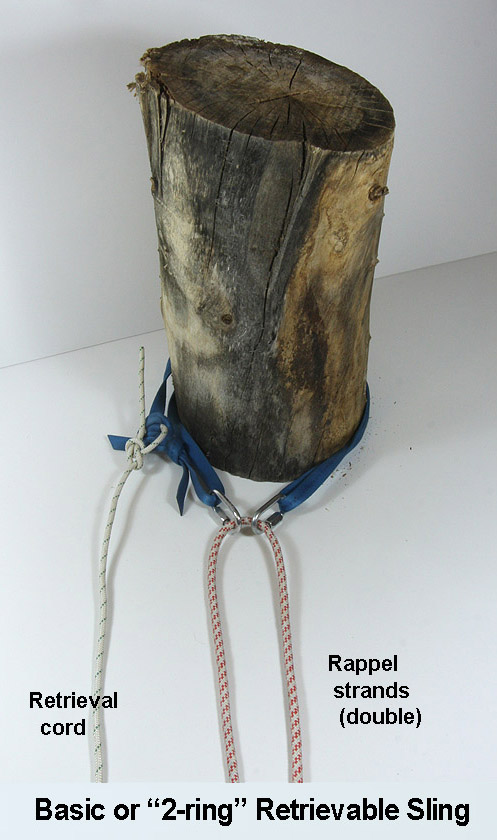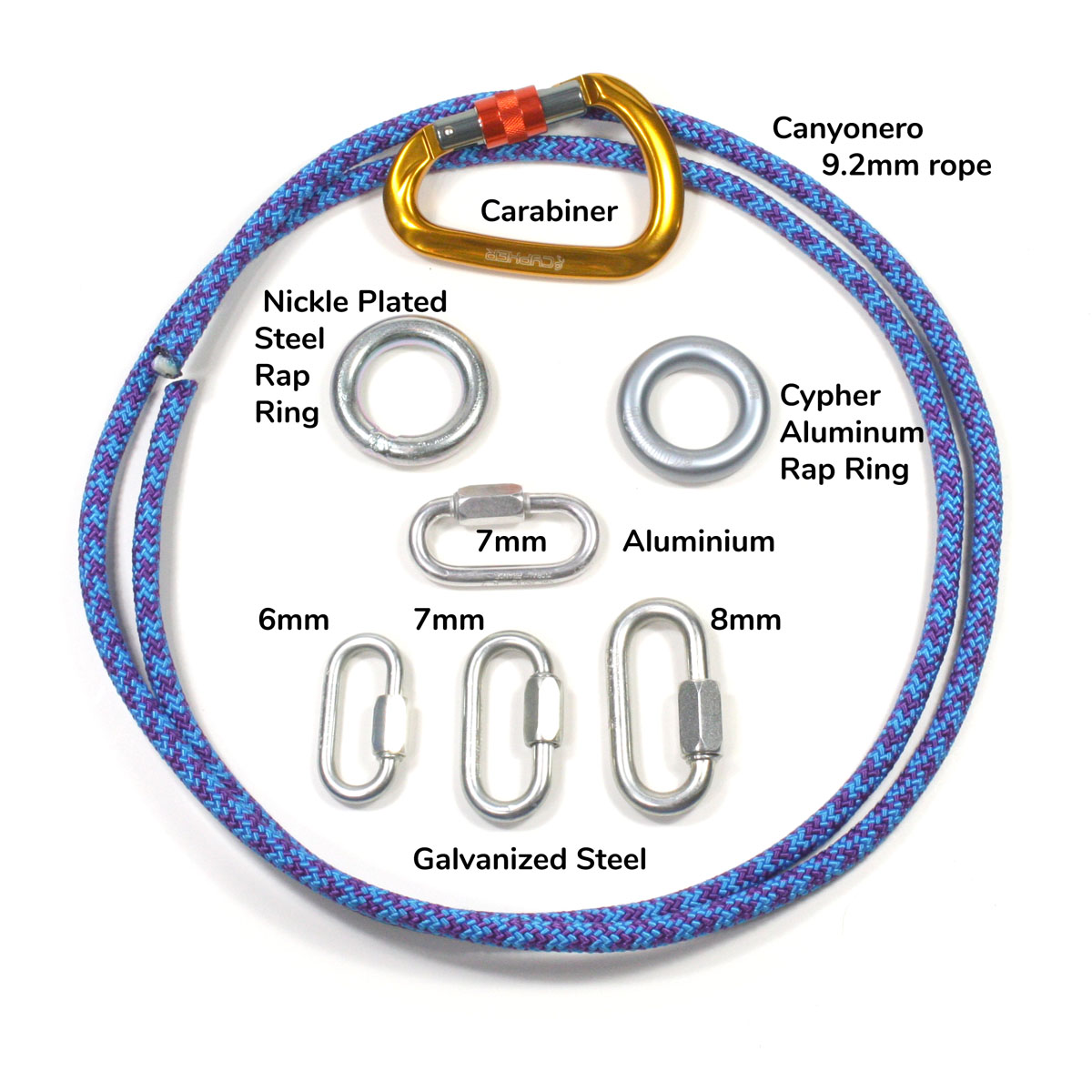How to Rig a 2-Ring Retrievable Anchor
"Retrievable Anchors" are those where the webbing used to form an anchor is retrieved, leaving nothing behind. There are several good reasons for doing this including:
leaving no trash behind in the canyon is elegant
in places where the anchor sling is visible to hikers, removing it is generally a good idea to decrease the visual impact, and in many places is good to avoid the potential wrath of land managers
a retrievable anchor may be a good way to conserve anchor materials
Of the many ways to retrieve anchor materials, this is the simplest and safest method. This is called a "3X" solution, as it requires three times the length of the rappel in rope/pull cord.
[A]. Make a 2-ring sling: tie a sling with a ring on each end. It can be single strand or double strand, long or short. It can be a good idea to use aluminum rings or rapid links, so that they hurt less when they fall on your head.
[B]. Locate an anchor that is strong, well-positioned, and where the sling, when pulled, will not get caught. It may be helpful to fill in spaces with sand, dirt or rocks to improve the smoothness of the pull.
[C]. Put your sling around the tree. Load your rope into both rings, and set the rope length for a single-line/blocked rappel, or a simple double-line rappel.
[D]. Tie a pull cord to one side of the sling. It is best not to tie the pull cord to the ring, as it may tangle with the rappel rope.
[E]. Everyone rappels using the rappel strands. Be careful to keep the strands separate so no one hooks onto the pull strand, it will pull, causing the anchor to fail while rappelling. A good technique is to not throw the pull strand down until the last rappeller is at the anchor station.
[F]. Retrieve the rappel rope.
[G]. Retrieve the sling, using the pull cord.
For other situations, there are other methods that might work better, but this is the most basic, and most useful, retrievable anchor. It has the distinct advantage of using stuff you already carry.
Some Things to Watch Out For
Think about which way to pull the sling. Sometimes the sling with ring will pull through clean in one direction, but not in the other. If you are going over an arch, generally pulling over the top will work better. If uncertain, try some test pulls, from a few feet away if the geometry allows, or from below if the geometry does not.
When NOT to use this kind of sling
In addition to locations where it might get stuck, you would also want to be very certain that this will stay in place when rappelling. For instance, there can be rocks that can be tied off tightly around their base, but draping this sling around it less-tightly makes it possible for the sling to pop up over the top of the rock. Perhaps more tempting would be small, flexible trees aka saplings. While the tree may be strong enough to anchor a rappel, it may be so flexible that while rappelling, the sling might slide up a bit, bend the tree and slide off the top. In this case, installing a conventional sling that grips the tree (e.g., Wrap Two, Pull One) is probably a better idea.
Why not just put the rope around the tree, rock, arch or log?
There are some circumstances where it works to just put the rope around the object. Using the two-ring retrievable sling, after pulling the rope, there is very little weight on the retrievable sling, so it tends to be easy to pull and not damaging to the environment. In choosing to just put the rope around the anchor, there are two main things to consider: A. Will the rope pull?; and B. Will pulling the rope damage the environment?
Will the rope pull?
If the object is smooth, and the rappel short, the rope might pull easily. But rocks and trees often have rough surfaces, and it may or may not be easy to pull the rope from around the anchor when you are at the bottom. If in doubt, do a test pull. There are many places where rocks with sharp edges can be used with a 2-ring sling, but trying to pull the rope around it will prove fruitless.
Will Pulling the Rope Cause Damage?
Probably a better reason to not just put the rope around a tree or arch is because it screws up the environment. Around live trees, even short pull-downs will cut the bark on the tree, and repeated pulls will kill the tree. So, Just Say No to draping live trees.
Around arches, pulling the rope over the arch will usually cut grooves into the rock, even if the pull is short. So just say NO to that too. In a non-sandstone environment, perhaps tossing the rope over an arch will work, but then you run into the pulling problem... so maybe a 2-ring sling would work better anyway.
So When Does Just Draping the Rope Work?
The most common anchor where this works is on barkless logs. The nice smooth surface allows for an easy pull. Since the tree is already dead, killing it further is unlikely. Clean logs can be great anchors, when the opportunity presents itself. In beginner canyons, it might be good to toss a sling and ring around the log, to "flag" the anchor for future parties.
Next in This Series: Retrievable Anchor, without the two-ring sling.
Note: Top-of-Article photographs may or may not have anything to do with the post.





